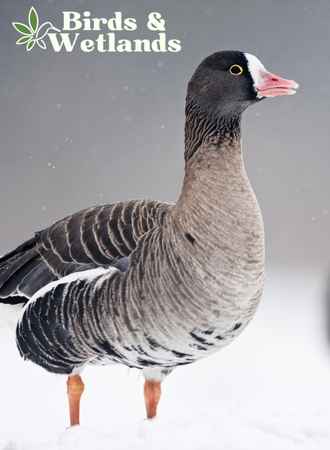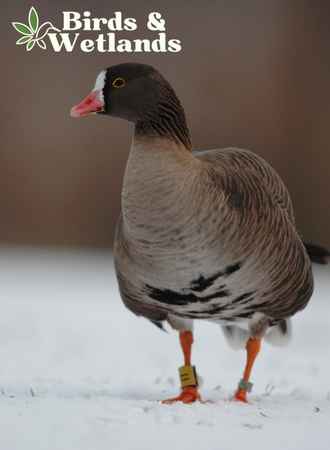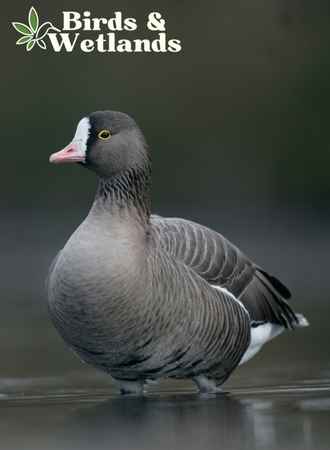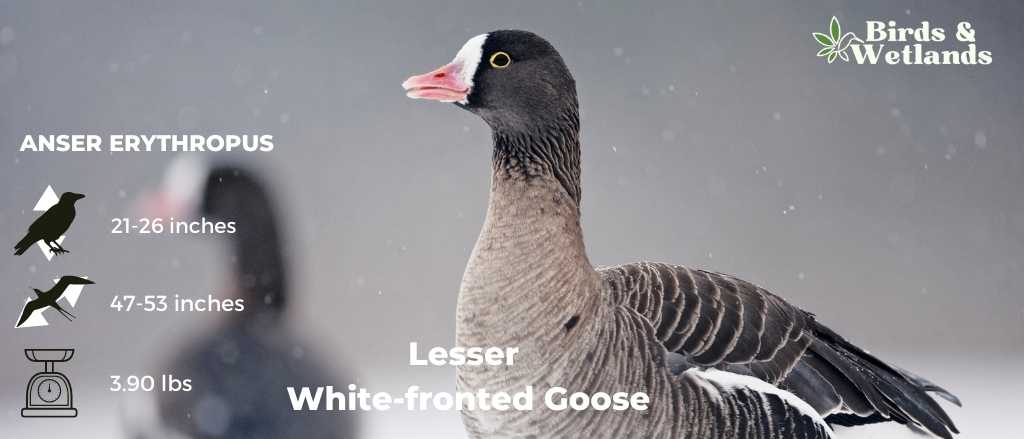The lesser white-fronted goose, or Anser erythropus, is a goose found in the northern parts of Europe, Asia and North America. This species is closely related to the larger white-fronted goose. Like its close relative, the lesser white-fronted goose breeds in the arctic tundra during the spring and summer. In addition to their range in Europe, these geese have also been re-introduced in Fennoscandia through breeding programs to grow their population numbers.
The lesser white-fronted goose is closely related to other white-fronted geese such as the Russian white-fronted goose and Greenland white-fronted goose.
Scientific Name: Anser erythropus
Height: 53–66 cm (21–26 in)
Wingspan: (120–135 cm 47–53 in)
Weight: 1.8 kg
Lesser White-Fronted Goose Description
The lesser white-fronted goose is a medium-sized, dark chocolate brown bird with a distinctive white forehead, bright-orange legs and bubblegum pink bill. Both the lesser white-fronted geese and greater white-fronted geese share some similarities in appearance but the two species differ in size. The greater white-fronted goose is slightly larger than the lesser white-fronted goose. Additionally, the lesser white-fronted goose has a short neck, narrow yellow eyering, a more extensive white forehead and a more stubby, distinct bill.

Russian White-Fronted Goose
The Russian white-fronted goose is a medium-to-large goose with a distinctive appearance. It has a square-looking head and a short, small bill, a white tip on its tail and its adult birds are characterized by their small white forehead and highly variable black belly barring. A young Russian white-fronted goose is often misidentified as a pink-footed goose due to similarities in appearance.
The Russian white-fronted geese have a large range that extends across Russia from eastern Siberia to the north to the Arctic Ocean. During the winter, these Russian birds typically migrate to East Asia, where it winters in regions like China, Japan, and Korea.

Listen to Lesser White-Fronted Goose
Lesser White-Fronted Goose Habitat
The lesser white-fronted geese are a goose found in the tundra habitats of arctic and subarctic regions. These birds are typically seen as singles or in small groups among larger flocks of other geese, and they breed in scrubby tundra areas with tall grasses and dense growths of willow trees.
During the winter months, the lesser white-fronted geese tend to migrate to more agricultural areas, such as salt marshes, wetlands and other wetland environments, as well as areas with drier conditions.
Given their adaptability and flexibility, you can find these birds near their typical breeding grounds during their migration and wintering periods. Thus, their habitat is quite diverse and can encompass a wide range of different types of landscapes depending on the season.

Lesser White-Fronted Goose Range
The lesser white-fronted goose is a migratory bird with a broad range that encompasses northern Europe, Russia, and parts of Asia. They breed in northern Norway, where large flocks build their nests in remote Arctic tundra habitats and overwinter in agricultural fields in areas such as Greece, Bulgaria, and Turkey.
While one of the most well-known stopover sites for these geese is at Hortobágy National Park in Hungary, where they spend up to two months during the autumn and one month during spring migration. Like most migratory birds, lesser white-fronted geese also have smaller breeding populations scattered across northern Sweden.
This goose species is easily adaptable to different environments due to its wide geographic range and impressive migration patterns.

Lesser White-Fronted Goose Diet
Lesser white-fronted geese are a migratory species that fly thousands of kilometers every year to escape the harsh winters of their northern breeding grounds. Their diet primarily consists of plant matter, including sedges, grasses, mosses, and seeds. They also eat a variety of aquatic vegetation, like water lilies and other plants that grow in or near shallow bodies of water.
In summer months, when sources of food are more abundant, these geese use their short bill to consume small quantities of invertebrates, like insects, worms, or mollusks. With their long, narrow beaks and high levels of agility and coordination, lesser white-fronted geese are excellent foragers. They can often be found grazing on land or scooping up mouthfuls of water in search of prey.

Lesser White-Fronted Goose Nesting & Mating Habits
The lesser white-fronted goose’s nest is typically a simple scrape in the ground, commonly found on deserted foothills near lakes or rivers.
Furthermore, female lesser white-fronted geese lay an average of 3 to 4 eggs during the spring nesting season, which lasts for about three weeks before hatching.
After hatching, young goslings remain close to their parents and learn about migration from them.
Additionally, geese families tend to be very close-knit, with long-term pair bonds commonly lasting throughout the birds’ lifetimes. As such, if one lesser white-fronted goose were to die prematurely, its mate would likely remain alone for the remainder of its life.
Lesser White-Fronted Goose Population & Conservation Status
The lesser white-fronted goose is a species of goose that has experienced significant declines in recent years due to habitat loss and poaching. Despite its designation as an endangered species, efforts are underway to reintroduce the goose into the wild and strengthen the population.
Various sources indicate that there are currently between 20 breeding pairs or 60-80 individuals, with major population strongholds in northern Norway, Greece, Bulgaria, and Turkey. In addition, a sizable portion of the population spends time each year at Hortobágy National Park in Hungary, where they rest and feed during their seasonal migrations.
Another significant population of lesser white-fronted geese is found in northern Sweden. Although still considered endangered, recent estimates put this population at around 15 breeding pairs or 40-50 individual birds.
Efforts to promote and protect this species are ongoing at local and global levels. With continued conservation measures and public support, this graceful bird is believed to continue to flourish for generations to come.
The lesser white-fronted goose is considered a vagrant species in North America. Currently, there is no data about resident populations in any state.

Key Takeaways
- The lesser white-fronted goose and greater white-fronted goose are closely related species of geese.
- The lesser white-fronted goose’s diet primarily consists of plant matter, including sedges, grasses, mosses, and seeds.
- The lesser white-fronted goose is considered a vagrant species in North America.


